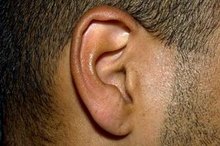Zygomaticus and Pain
The zygomaticus muscles make it possible for you to speak, chew and use your face to express emotions. You can injure these muscles by overuse or trauma. Because they are connected to the eye socket and the jawbone, injuries, irritation or disease in these areas can affect the zygomaticus as well. Some types of zygomaticus pain can heal with rest, but chronic pain may indicate a serious condition.
If you are experiencing serious medical symptoms, seek emergency treatment immediately.
Definition
The zygomaticus is a group of small muscles that runs along the cheekbone from your eye socket to your lip. They attach to the zygomatic bone -- also called the cheekbone -- and receive nourishment from the facial artery. The zygomaticus major controls movement of your upper lip outward and upward, and specifically is responsible for smiling. The zygomaticus minor sits in front of the zygomaticus major and helps the larger muscle move your upper lip up and out, and also moves the lip backward. You use it when you frown or express sadness.
- The zygomaticus is a group of small muscles that runs along the cheekbone from your eye socket to your lip.
- The zygomaticus minor sits in front of the zygomaticus major and helps the larger muscle move your upper lip up and out, and also moves the lip backward.
Squeezed Blood Vessels
TMJ Exercises for Slipped Disc
Learn More
The blood vessels that run between your cheek and your nose can become trapped between the layers of the zygomaticus muscles. Prolonged use of the facial muscles -- such as smiling, talking or chewing a lot during a social event — or physical trauma to the area can cause this condition. The muscles press on the entrapped blood vessels, which restricts the flow of blood. This, in turn, causes the muscles to cramp due to lack of nourishment. The pain feels much like sinus pressure, but the cause is on the outside of the cheek bone rather than from the sinus sacks inside.
- The blood vessels that run between your cheek and your nose can become trapped between the layers of the zygomaticus muscles.
- The pain feels much like sinus pressure, but the cause is on the outside of the cheek bone rather than from the sinus sacks inside.
Temporal Tendinitis
Temporal tendinitis is a swelling of the tendon that runs from the temple to the jaw. This inflammation can cause pain in the zygomaticus region, as well as headache, ear pain, jaw soreness and eye ache. It is sometimes confused with sinusitis, but your doctor or dentist can test for this condition by palpating the temporal tendon. Treatment may involve rest, anti-inflammatory drugs or a device to prohibit teeth clenching. In rare cases where the tissue has degenerated, you may need surgery to remove the damaged tissue.
- Temporal tendinitis is a swelling of the tendon that runs from the temple to the jaw.
- It is sometimes confused with sinusitis, but your doctor or dentist can test for this condition by palpating the temporal tendon.
Fracture
5 Things That Cause Pain Behind the Ear and Down the Neck
Learn More
Pain in the zygomaticus also can be the result of a fractured cheekbone. Such fractures occur in traffic accidents, falls and contact sports. Because the cheekbone is connected to both your eye socket and your jaw, you also may experience eye or mouth pain. Though not always visible to the naked eye, such fractures can cause internal bleeding and may affect brain function. You may need an x-ray or CT scan to determine if you have such a fracture.
- Pain in the zygomaticus also can be the result of a fractured cheekbone.
- Because the cheekbone is connected to both your eye socket and your jaw, you also may experience eye or mouth pain.
Related Articles
Writer Bio
A retired federal senior executive currently working as a management consultant and communications expert, Mary Bauer has written and edited for senior U.S. government audiences, including the White House, since 1984. She holds a Master of Arts in French from George Mason University and a Bachelor of Arts in English, French and international relations from Aquinas College.








